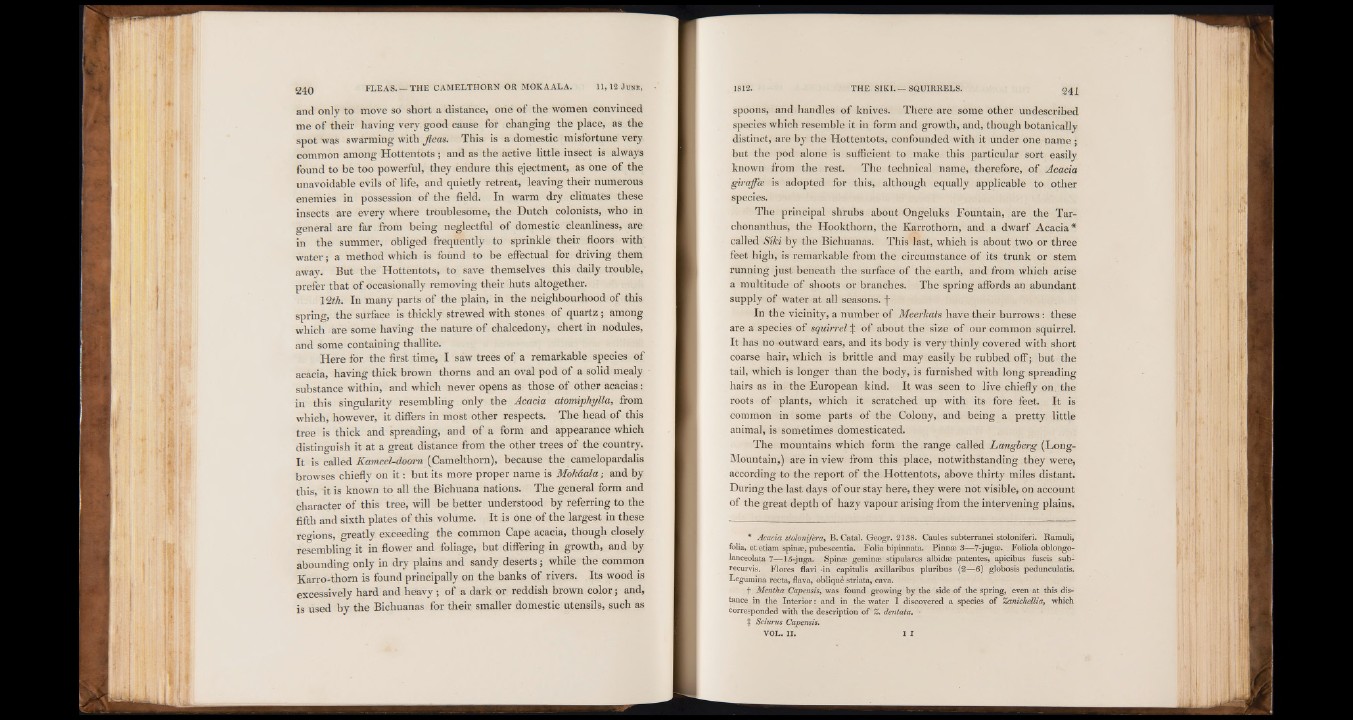
and only to move so short a distance, one of the women convinced
me of their having very good cause for changing the place, as the
spot was swarming with fleas. This is a domestic misfortune very
common among Hottentots; and as the active little insect is always
found to be too powerful, they endure this ejectment, as one of the
unavoidable evils of life, and quietly retreat, leaving their numerous
enemies in possession of the field. In warm dry climates these
insects are every where troublesome, the Dutch colonists, who in
general are far from being neglectful of domestic cleanliness, are
in the summer, obliged frequently to sprinkle their floors with
water; a method which is found to be effectual for driving them
away. But the Hottentots; to save themselves this daily trouble,
prefer that of occasionally removing their huts altogether.
12th. In many parts of the plain, in the neighbourhood of this
spring, the surface is thickly strewed with stones of quartz; among
which are some having the nature of chalcedony, chert in nodules,
and some containing thallite.
Here for the first time, I saw trees of a remarkable species of
acacia, having thick brown thorns and an oval pod of a solid mealy
substance within, and which never opens as those of other acacias:
in this singularity resembling only the Acacia atomiphylla, from
which, however, it differs in most other respects. The head of this
tree is thick and spreading, and of a form and appearance which
distinguish it at a great distance from the other trees of the country.
It is called Kameel-doom (Camelthorn), because the Camelopardalis
browses chiefly on it : but its more proper name is Mokaala; and by
this, it is known to all the Bichuana nations. The general form and
character of this tree, will be better understood by referring to the
fifth and sixth plates of this volume. It is one of the largest in these
regions, greatly exceeding the common Cape acacia, though closely
resembling it in flower and foliage, but differing in growth, and by
abounding only in dry plains and sandy deserts; while the common
Karro-thom is found principally on the banks of rivers. Its wood is
excessively hard and heavy; of a dark or reddish brown color; and,
is used by the Bichuanas for their smaller domestic utensils, such as
spoons, and handles of knives. There are some other undescribed
species which resemble it in form and growth, and, though botanically
distinct, are by the Hottentots, confounded with it under one name;
but the pod alone is sufficient to make this particular sort easily
known from the rest. The technical name, therefore, of Acacia
giraffee is adopted for this, although equally applicable to other
species.
The principal shrubs about Ongeluks Fountain, are the Tar-
chonanthus, the Hookthorn, the Karrothorn, and a dwarf Acacia*
called Siki by the Bichuanas. This last, which is about two or three
feet high, is remarkable from the circumstance of its trunk or stem
running just beneath the surface of the earth, and from which arise
a multitude of shoots or branches. The spring affords an abundant
supply of water at all seasons, f
In the vicinity, a number of Meerkats have their burrows: these
are a species of squirrel!! of about the size of our common squirrel.
It has no outward ears, and its body is very thinly covered with short
coarse hair, which is brittle and may easily be rubbed off; but the
tail, which is longer than the body, is furnished with long spreading
hairs as in the European kind. It was seen to live chiefly on the
roots of plants, which it scratched up with its fore feet. It is
common in some parts of the Colony, and being a pretty little
animal, is sometimes domesticated.
The mountains which form the range called Langberg (Long-
Mountain,) are in view from this place, notwithstanding they were,
according to the report of the Hottentots, above thirty miles distant.
During the last days of our stay here, they were not visible, on account
of the great depth of hazy vapour arising from the intervening plains.
* Acacia stolonifera, B. Catal. Geogr. 2138. Caules subterranei stoloniferi. Ramuli,
folia, et etiam spinse, pubescentia. Folia bipinnata. Pinnae 3—7-jugse. . Folióla oblongo*
lanceolata 7—15-juga. Spinse geminse stipulares albidae patentes, apicibus fuscis sub-
recurvis. Flores flavi -in capitulis axillaribus plunbus (2—6) globosis pedunculatis.
Legumina recta, flava, oblique striata, cava.
■}■ Mentha Capensis, was found growing by the side of the spring, even at this distance
in the Interior: and in the water I discovered a species of Zanichellia, which
corresponded with the description of Z. dentata. -
t Sciurus Capensis.
VOL. II. I I